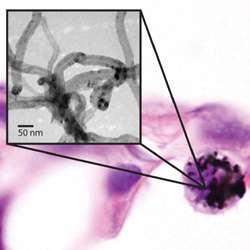Study shows how carbon nanotubes can affect lining of the lungs

(PhysOrg.com) -- Carbon nanotubes are being considered for use in everything from sports equipment to medical applications, but a great deal remains unknown about whether these materials cause respiratory or other health problems. Now a collaborative study from North Carolina State University, The Hamner Institutes for Health Sciences, and the National Institute of Environmental Health Sciences shows that inhaling these nanotubes can affect the outer lining of the lung, though the effects of long-term exposure remain unclear.
Using mice in an animal model study, the researchers set out to determine what happens when multi-walled carbon nanotubes are inhaled. Specifically, researchers wanted to determine whether the nanotubes would be able to reach the pleura, which is the tissue that lines the outside of the lungs and is affected by exposure to certain types of asbestos fibers which cause the cancer mesothelioma. The researchers used inhalation exposure and found that inhaled nanotubes do reach the pleura and cause health effects.
Short-term studies described in the paper do not allow conclusions about long-term responses such as cancer. However, the inhaled nanotubes "clearly reach the target tissue for mesothelioma and cause a unique pathologic reaction on the surface of the pleura, and caused fibrosis," says Dr. James Bonner, associate professor of environmental and molecular toxicology at NC State and senior author of the study. The "unique reaction" began within one day of inhalation of the nanotubes, when clusters of immune cells (lymphocytes and monocytes) began collecting on the surface of the pleura. Localized fibrosis, or scarring on parts of the pleural surface that is also found with asbestos exposure, began two weeks after inhalation.
The study showed the immune response and fibrosis disappeared within three months of exposure. However, this study used only a single exposure to the nanotubes. "It remains unclear whether the pleura could recover from chronic, or repeated, exposures," Bonner says. "More work needs to be done in that area and it is completely unknown at this point whether inhaled carbon nanotubes will prove to be carcinogenic in the lungs or in the pleural lining."
The mice received a single inhalation exposure of six hours as part of the study, and the effects on the pleura were only evident at the highest dose used by the researchers - 30 milligrams per cubic meter (mg/m3). The researchers found no health effects in the mice exposed to the lower dose of one mg/m3.
More information: The study, "Inhaled Carbon Nanotubes Reach the Sub-Pleural Tissue in Mice," the study is published in the Oct. 25 issue of Nature Nanotechnology
Source: North Carolina State University (news : web)
















